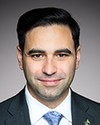Honourable Chair, vice-chairs, and members of Parliament, my name is Martin Mark. I work for the Roman Catholic Church at the Office for Refugees of the Archdiocese of Toronto. We are one of the 100 SAHs, sponsorship agreement holders.
Last year we initiated to resettle over 2,300 refugees from all over the world, and in March, in an unexpected blitz, we submitted 700 additional files that were sitting in our office from last year. This over-3,000-person resettlement, compared to our allocation by the immigration department for this year—only 1,000—is not really encouraging.
We might be a little different from other members of the SAH association. For example, we conduct regular mission trips to visit refugee camps and communities to identify, select, and screen refugees for resettlement. There is a young man sitting behind me; we met him five years ago in a refugee camp, and thanks to Citizenship and Immigration Canada, he is now a Canadian. This is his first summer here.
This is a different method that we use, and in a week from now, at this time exactly, I will be sitting in a refugee camp in the Middle East, most probably with the Yazidi people.
Thank you for the invitation, and thank you for choosing this forgotten but crucial topic, which is related to the majority of those affected by the worldwide refugee crisis of our day. It has probably never before been discussed at such a high level, so our hopes are up.
Something went wrong, and we have to correct it before it's too late. It is well known internationally how generous Canada is when it comes to humanitarian efforts, especially in helping refugees. In my work, both locally and internationally, I hear a lot of praise and appreciation for what Canada and Canadians have done and continue to do for uprooted people. There are 100,000 people, if not a million people, who have found peace, safety, and unparalleled opportunity for a dignified and prosperous life for themselves and their children because of the Canadian refugee protection system in the past three decades and more.
Besides the inland protection and overseas resettlement, Canada was and is open to refugees who can afford to use other immigration venues and arrive without the label “refugee”. Some economic migrants, business people, and other migrants are also people who were forced to migrate; however, they have had a chance to use other than refugee methods to arrive in the safety of Canada.
First, it is important to leave other immigration venues open so that these refugees who can manage their lives should not be forced to use the limited resettlement spots that we have. As a private sponsor board or, as I prefer to call it, a civic resettlement, we have seen great improvements and a significant increase in the past years. However, we have lost a lot of options and we did not get long-awaited basic improvements.
When we focus on vulnerable groups and individuals in the context of resettlement, the first issue we might want to address is direct access. Direct access was the policy of Canadian embassies for decades. It meant that people living in their own country, once they felt that their situation was dangerous and life-threatening, had the option to approach the Canadian representative to ask for protection. This was also fair in ensuring that people were not waiting for decisions for long years or decades in refugee camps, as people did.
In 2002 the Immigration and Refugee Protection Act, IRPA, limited access to a small number of countries, which were actually also the so-called “source countries”. By 2012, with the changes in the regulations, together with the elimination of the source countries, direct access was closed also.
The source country class had a very important role in providing protection. We know it did not function well in several situations. However, to close it means that today Canada excludes a majority of forced migrants. Of the 65 million people of concern to the UN, only 21 million are refugees who are eligible for the Canadian refugee protection system—resettlement or anything else—while the majority of uprooted people are IDP, internally displaced peoples. Thus, we exclude 41 million people in need. Something went wrong, and we have to correct it before it's too late.
Now let's talk about the nature of conflicts that create refugee situations and how to react to them.
In the 20th century, the main causes of conflicts were nationalism, racism, and political power hunger. This dramatically changed in the late 21st century. The power struggle is there as the main motivation in several conflicts; however, in most cases, it is with religious cover.
What we see worldwide now is a series of predominantly religious conflicts. A good example is Somalia. When we started to resettle Somali refugees, we had to help the minority clans—Bajunis, Madhiban, and others—because the biggest threat was based on their origin. They were targeted due to their ethnicity. Now we resettle Somalis because of al Shabaab. It has nothing to do with clans anymore. The only motivation is religious extremism.
In the last century, in the Yugoslavian war, the Serbian militants were fighting against both Christians and other Muslims, such as Croatians and Bosnians, because their motivation had nothing to do with faith: they did ethnic cleansing regardless. We resettled them, both Christians and Muslims. They were targeted and they were victims.
The main issue is to identify why the person is persecuted.
In Iraq, when ISIS members place a symbol on a house, they focus on the person's belief. “Nazarene” means “Christian”, so they target them based on their faith. Persecuting the Yazidis and other minorities is based on their faith, and in this way they become the most vulnerable group, with no significant help and unbelievable abuse and extreme torture.
With One Free World International and Reverend Majed El Shafie and Chantal Desloges' law firm, we worked on a proposal on how to raise awareness for the Yazidis, the most abandoned group in the history of persecution and refugee protection. It is up to you to give the legal framework, but in our project proposal we describe a possibility of a pilot project to help these internally displaced people, who have no political or religious lobby to get help and are somehow forgotten.
With opening up the source country class or with ministerial public policy decisions, civic sponsors could start helping these traumatized communities in desperate need. If you are serious about helping the most vulnerable, if you are serious about ensuring support for the safety of women at risk, as usually we Canadians proudly state, then there is no group in the world right now that is more in need of help than they are.
I would be pleased to discuss this further, but due to the time constraints, let me just briefly mention two issues in closing.
Processing times in several places worldwide are about three to five years. As one of the refugee singers wrote in his song for us, protection delayed means protection denied. We are losing selected and screened refugees to other resettlement countries, even to Australia. This is happening even in the Middle East, where we are very happy to say that Canadian processing is extremely fast. The backlog in the resettlement system in some parts of the world makes Canadian resettlement nearly impossible.
Finally, talking about vulnerable groups, we should not forget the most vulnerable: unaccompanied minors and children. In our resettlement programs, usually unaccompanied children are excluded. This is extremely sad and wrong. If you go to the Yazidis, you find an abused young woman under 18, whom we might not be able to help because of the ban on resettlement. Why don't we follow the U.S., which has an extremely successful program helping minors? We shouldn't just abandon children in the camps.
Thanks, and I wish you great success in this area of work. We can give hope for the most hopeless if we work together.
Thank you.


